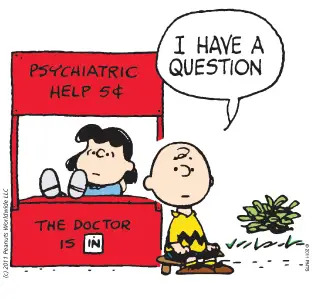With a surplus of health and parenting available on the Internet, it’s a challenge for parents to determine what they should take or leave. Here, pediatrician Dr. Alan Greene offers up advice for first-time and seasoned parents on raising healthy, happy kids.
In 1950, America met Charlie Brown. The animated Peanuts gang represented an imaginative kids’ world where the adult’s voice was limited to “mwa mwa mwa.”

No tiger moms here. And over the next couple of decades in the real world, kids (likely some of us) roamed around the back seats of cars unencumbered by safety straps or booster seats, pregnant women smoked nonchalantly (with the overwhelming volume of often-contradictory advice that parents today are hit with).
Are today’s parents going to the opposite extreme of our ’50s and ’60s counterparts? Pediatrician Dr. Alan Greene weighs in with his advice.
With an Internet full of health information at our disposal and an overwhelming amount of potential problems to worry about with your new baby or toddler, how can you determine what’s smart to be concerned about and what you should just let go?
Sometimes parent’s best intentions to raise happy and healthy children and protect them from harm come across as “over-parenting.” This is especially true for insecure first-time parents.
In the first weeks, colic is a big deal. Beyond this, most of the rapidly increasing conditions in today’s children are linked to how kids eat, how kids move, and/or environmental exposures. In these areas parents can make big changes with a small amount of attention.
Colic
Colic can be very distressing both for babies and their parents. Parents often feel their baby’s screaming is an indictment of their parenting ability: there’s something wrong with me; there’s something wrong with my milk; or there’s something wrong with my baby! It’s no wonder that so many feel frustrated, exhausted, guilty, angry, or helpless.
Many solutions to colic have been proposed. Some remedies have been tested and found not to work (such as simethicone drops, one of the most common remedies given to babies). Most colic solutions help in about one-third of babies, but it’s hard to predict which babies will benefit. Combining remedies is often the most helpful.
Here are 10 tips:
Motion. Some families report relief with gentle movement, whether from a swing, a car ride, a ride in a jogging stroller, or a parent’s arms.
Massage. Baby massage in general and belly massage in particular. A warm bean bag can be a nice tool for this. Some babies are helped with the addition of one of the infant vibrating products during massage.
Changing mother’s diet. For breastfed babies, eliminating certain foods can help. Cow’s milk, eggs, nuts, or wheat are the most likely to make a difference-especially if there is asthma, eczema, or allergies in the family.
Changing to a hypoallergenic formula. For formula-fed babies, the switch is sometimes powerful.
Changing bottles. Any bottle change can produce improvement in some babies. In one clinical trial, switching to BornFree bottles with ActiveFlow made a significant difference for 80 percent of babies.
Changing feeding technique. Switching from nursing at both breasts at each feed to prolonged emptying of one breast cut colic in half in one study. Sucking on a pacifier or thumb between feeds can help whether a baby is breast- or bottle-fed.
Soothing noise. Heartbeat recordings, white noise machines, recordings of babies yawning, or the gentle voices of parent’s sshhing, humming, or singing a lullaby.
Swaddling. Being wrapped snuggly comforts some babies.
Herbal remedies. Chamomile, fennel, and balm mint have appeared effective in some studies.
Probiotics. Compared to placebo, taking beneficial bacteria reduces crying for some.
Nutrition and Obesity
With the explosion of obesity among children, teaching your child to recognize and enjoy healthy amounts of good food is wise. I call this cultivating “nutritional intelligence.” There are windows of opportunity when children are first exploring solid foods that are the easiest times to increase your child’s nutritional intelligence. You can easily help to train children’s palates by introducing a variety of real foods-the foods you want them to grow up loving. It’s a powerful way to prevent childhood obesity.
One of the most common first foods for babies-and the dominant source of solid-food calories for the first year-is the processed white rice flour that we call rice cereal. It’s no wonder that we have a generation of children where refined-flour sweets are the number-one source of calories for children from age 2 to 18, where white bread dominates and whole grains are scarce.
By simply selecting real foods—mashed avocados, bananas, sweet potatoes, or whole grains (like whole oats or brown rice)—for your baby’s earliest exposure to solids, you will be teaching her to love these healthy options. When you do introduce grains, let every child’s first grain be a whole grain. And here’s the great news: Your children won’t mind.
Chemicals and Household Toxins
There are about 80,000 chemicals in the marketplace today, more than enough to make parents who are concerned about chemicals pull out their hair.
Simplify and pay attention to just 3 ways your child might be exposed.
What goes in the mouth. Choose clean food and drinks, and pay special attention to the plastics that go in the mouth, especially those used to store, heat, or serve food and drinks. Chemicals in the plastics can leach out and enter your child’s body. Notice the recycling symbols on the bottoms of many plastics. Opt for symbols 1, 2, 4, or 5. Or choose brands like BornFree, where the entire line of toddler sippy cups, pacifiers, baby bottles and plastic water bottles are free from BPA, phthalates, and PVC. Or skip plastic altogether, and go with glass or stainless steel.
What goes on the skin. Chemicals in lotions and creams can be absorbed through the skin. We read the ingredients on food; it’s time to learn to read ingredient lists on skin products as well, and choose those you trust. Sunscreen is a great place to start. I prefer sunscreens that rely on minerals, like zinc or titanium, rather than relying on chemicals that might act as hormones in the body.
What goes in the nose. Clean air may seem overwhelming. After all, you don’t have much control over other people’s exhaust pipes and smokestacks. But the air that matters most is the air in your own home, where your child sleeps at night. Indoor air is usually more polluted than outdoor air, so you can often make a big difference just by opening the windows. Replace cleaning products that have harsh fumes or artificial fragrances (anything that says, “use in a well-ventilated space” probably isn’t good for your child). Also, consider houseplants or an air filter to help clean your air.
Keeping it Simple
Focus on concerns that matter. Consider the simple foundation of good food, active play, and keeping kids safe from important hazards, seen and unseen. Stay on the lookout for simple solutions that have the biggest payoff-so you can spend most of your parenting time connecting with your kids and enjoying them. These years may seem like they’ll last forever, but they fly by so quickly. Don’t waste them worrying incessantly about things beyond your control.
Alan Greene, M.D. is the author of “Raising Baby Green, Feeding Baby Green,” and is an authority on children’s toxins, nutrition, and organics. Dr. Greene is a graduate of Princeton University and the University of California at San Francisco and is currently clinical professor of pediatrics at Stanford University School of Medicine, an attending pediatrician at Packard Children’s Hospital, and a Senior Fellow at the University California San Francisco Center for the Health Professions.





















